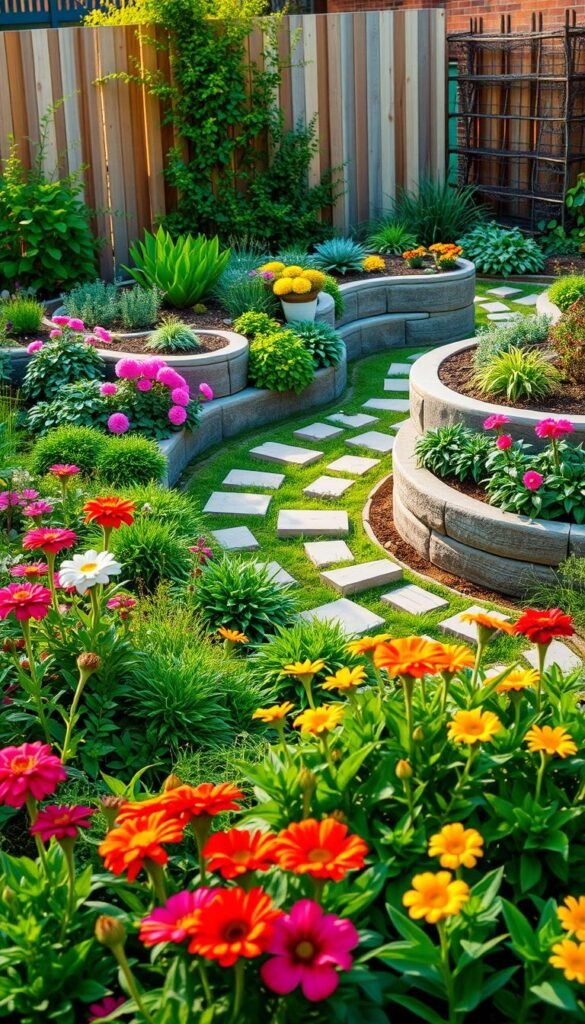Ready to turn your yard into a thriving, clutter-free paradise? Discover how clever layouts and strategic designs can make gardening simpler and more rewarding. This guide shares fresh approaches to growing plants in ways that save time, space, and effort.
You’ll learn practical methods tested by experts to boost harvests while keeping your outdoor area tidy. From budget-friendly setups to space-maximizing tricks, these strategies work for small patios or sprawling backyards. Even better, many use recycled materials like cedar or reclaimed wood – perfect for building cost-effective raised beds that last years.
New to planting? No problem. These concepts focus on easy maintenance without sacrificing beauty. Love experimenting? Try repurposing items like old ladders or crates for unique growing spaces. Every idea balances functionality with visual charm, helping you create a garden that’s as organized as it is productive.
By the end, you’ll have actionable tips to design growing areas that fit your lifestyle. Get ready to enjoy healthier plants, bigger yields, and a yard that feels like your personal oasis.
Understanding the Benefits of Raised Bed Gardening
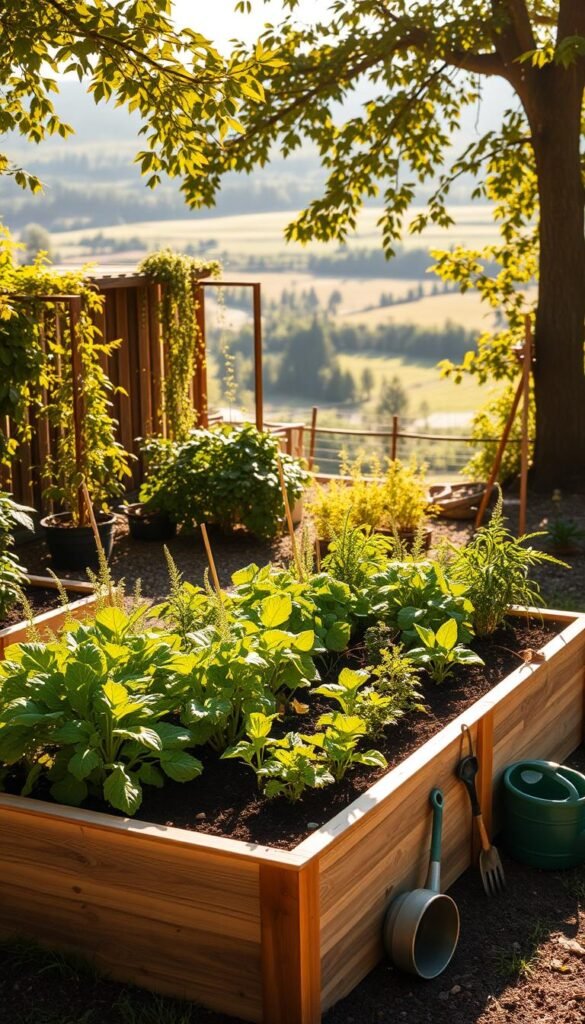
Imagine tending your plants without the usual aches and pains. Raised beds solve common growing challenges while boosting productivity. Their elevated design works smarter, not harder – for you and your plants.
Easier on the Knees and Back
No more bending like a pretzel to weed or harvest. Raised beds sit at waist height, letting you work upright. One gardener shared:
“After switching to raised beds, I finally enjoy gardening without needing ice packs afterward!”
Enhanced Soil Quality and Drainage
You control what goes into your soil mix – no guessing games with clay or rocky ground. Loose, nutrient-rich earth means roots breathe easier and grow stronger. Proper drainage stops waterlogged roots, cutting rot risks by up to 40% compared to traditional plots.
| Feature | Raised Beds | In-Ground Gardens |
|---|---|---|
| Accessibility | Waist-height design | Ground-level work |
| Soil Control | Custom blends | Native soil only |
| Drainage | Prevents pooling | Flood risks |
New to this method? Our complete raised bed gardening guide breaks it down simply. For hands-on help, try this step-by-step raised bed guide using basic materials.
Choosing the Right Materials for Your Raised Garden Bed
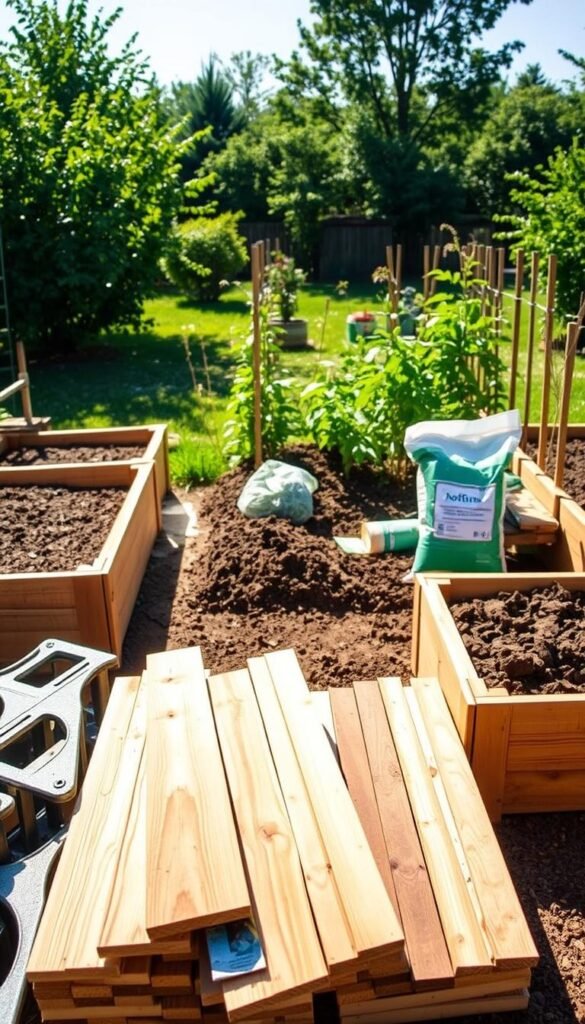
Your material selection shapes how long your planting space lasts and how well plants grow. Let’s explore options that balance durability, cost, and style to match your gardening vision.
Wood, Metal, and Recycled Options
Cedar remains a top pick for wooden beds. It resists rot naturally and looks great, though prices have climbed. Untreated pine works if you apply linseed oil yearly. One gardener noted:
“My pine bed lasted eight seasons – just sand and re-oil each spring!”
Galvanized steel beds surprise many. They’re lighter than they look and reflect heat instead of absorbing it. No rusty corners or baked roots – perfect for hot climates. Recycled materials? Old bricks or food-safe containers add charm. Just avoid treated railroad ties near edibles.
Pros and Cons of Each Material
Every option has trade-offs. Wood feels natural but needs upkeep. Metal lasts decades but costs more upfront. Recycled items save money but require safety checks.
| Material | Pros | Cons |
|---|---|---|
| Cedar | Rot-resistant, attractive | Higher cost |
| Steel | No maintenance, cool roots | Less rustic look |
| Recycled | Eco-friendly, unique | Limited sizes |
Stuck deciding? Mix materials! Use steel corners with wooden sides or add brick accents. Your bed should reflect your style while keeping plants thriving for years.
Tips for Successful DIY Raised Garden Bed Projects
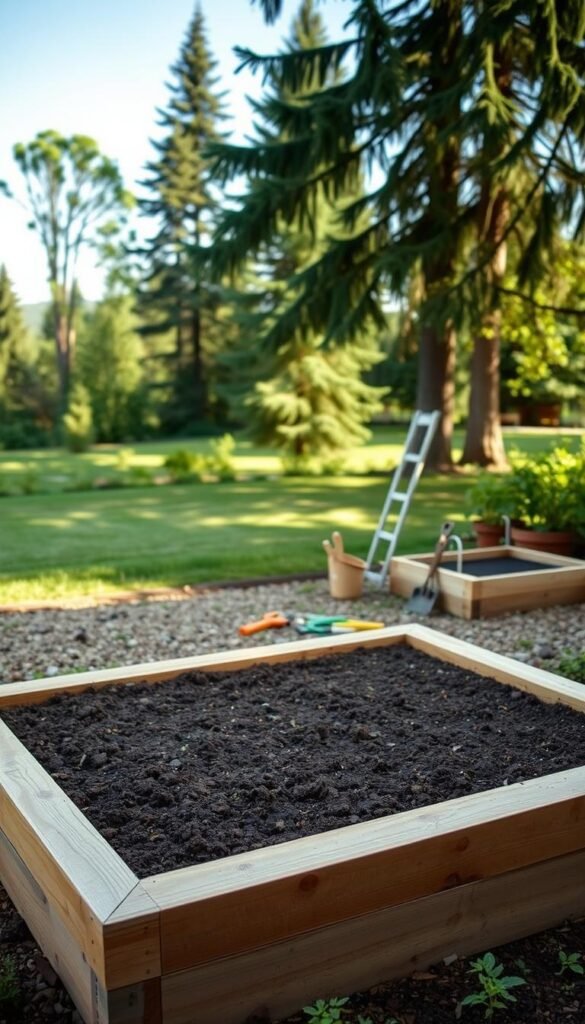
Building your own raised beds? Smart planning prevents frustration and wasted trips to the hardware store. Let’s break down how to nail your project from blueprint to harvest-ready setup.
Planning and Material Sizing
Measure your vehicle’s interior before buying lumber. One gardener learned the hard way:
“I drove home with 8-foot boards sticking out my sunroof – measure twice, load once!”
Sketch your design noting exact dimensions. Standard beds work best at 3-4 feet wide for easy reaching. Depth matters too – 12-17 inches of quality soil supports most vegetables.
Cost-Saving Measures and Practical Advice
Fill the bottom third with branches or leaves instead of expensive soil. This natural base decomposes over time, feeding plants while saving cash. Start with partial soil layers and add more later.
| Smart Move | Benefit |
|---|---|
| Reuse old bricks | Cuts material costs by 30% |
| Buy bulk soil | Lowers price per cubic foot |
| Double-check cuts | Prevents wood waste |
Tackle tricky steps first – like reinforcing corners – while you’re fresh. Quality screws beat nails for lasting stability. Your future self will thank you when those beds still stand strong in year five!
Exploring 8 Creative Garden Bed Ideas for Organized Planting
Who says order and creativity can’t coexist in your planting space? Professional growers have cracked the code for blending structure with artistic flair. Let’s explore fresh approaches that turn rigid rows into dynamic, thriving ecosystems.
Unique Concepts from Industry Experts
Ree Drummond’s “chaos gardening” method proves beauty thrives in controlled randomness. She combines tomatoes, basil, and marigolds in free-form clusters. “Let plants mingle like old friends at a dinner party,” she suggests. This approach boosts pest resistance while creating eye-catching color combinations.
“Chaos gardening isn’t messy – it’s nature’s version of perfect organization.”
Try these expert strategies for balanced layouts:
| Method | Space Used | Maintenance Level |
|---|---|---|
| Vertical stacking | 65% less ground area | Medium |
| Companion clusters | Standard footprint | Low |
| Rotating color zones | Flexible spacing | High |
Pair these techniques with smart square foot gardening layouts for maximum impact. One urban gardener reported doubling their harvest while cutting weeding time by half using these methods.
Elevating Your Garden with Raised Beds and Edible Plants
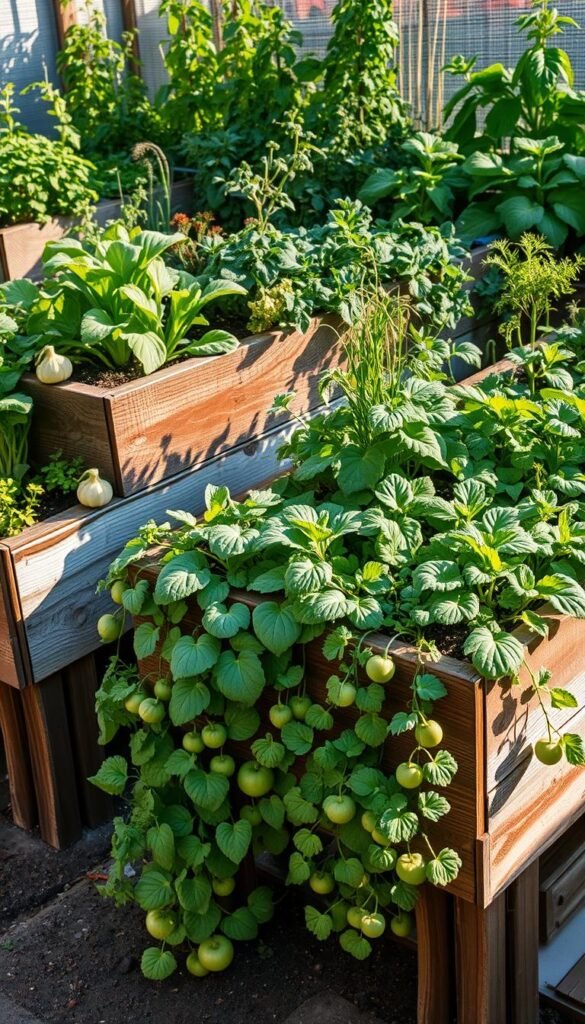
Transform your outdoor space into a vibrant mix of beauty and bounty. By blending edible and decorative varieties in raised beds, you create living art that feeds both body and soul. This method turns ordinary plots into multi-purpose spaces bursting with color, texture, and flavor.
Integrating Fruits, Vegetables, and Ornamentals
Why choose between pretty and practical? One gardener explains:
“My basil-tomato-marigold trio looks like a sunset painting – but it’s really a pest-fighting superteam!”
Companion planting in elevated beds offers hidden perks. Marigolds repel nematodes, while basil improves tomato flavor. These partnerships reduce chemical use and boost yields naturally.
| Planting Style | Benefits | Best For |
|---|---|---|
| Color-blocked zones | Visual impact | Small spaces |
| Vertical layers | Space efficiency | Climbing plants |
| Mixed clusters | Natural pest control | Beginner-friendly |
Raised beds give you precise soil control for fussy edibles like blueberries. Their quick-draining setup prevents root rot in moisture-sensitive vegetables. Plus, the extra warmth lets you grow heat-loving peppers even in cooler zones.
Try pairing purple kale with golden nasturtiums for striking contrast. Or let scarlet runner beans climb through flowering shrubs. Your space becomes a dynamic tapestry that changes weekly as different plants thrive.
Innovative DIY Ideas for Unique Garden Bed Designs
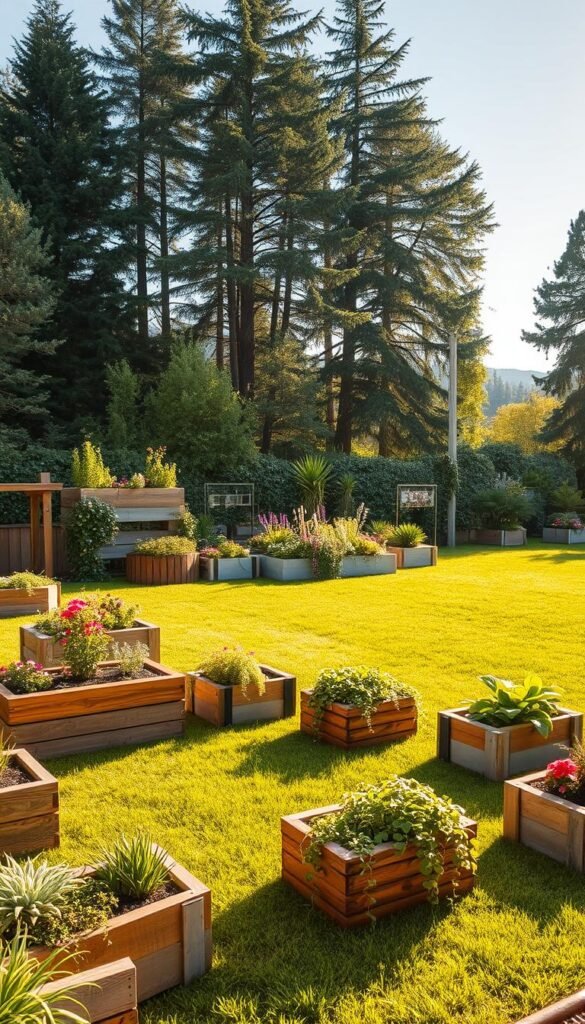
Turn everyday objects into eye-catching garden features with a little DIY magic. With some creativity, you can craft functional planters that spark conversations while growing healthy crops. Let’s explore clever ways to transform unexpected items into thriving growing spaces.
Repurposing Everyday Items like Wine Barrels and Suitcases
Old wine barrels become instant rustic charm for your yard. Drill five drainage holes in the bottom and set them on bricks for airflow. One gardener reported growing 24 strawberry plants in a single barrel – talk about space efficiency!
Vintage suitcases? Add gas pipe legs to create elevated planters. Line them with landscape fabric, poke drainage holes, and fill with herbs. Pro tip: Use chalk paint to refresh faded exteriors while keeping that retro vibe.
Custom PVC and Trellis Setups
PVC pipes offer endless possibilities. Build rectangular frames for shallow-rooted greens, or stack pipes vertically for strawberries. One innovative grower shared:
“My PVC bed doubles as a trellis – cucumbers climb one side while lettuce grows below!”
These lightweight systems let you experiment with layouts yearly. Attach shade cloth during heatwaves or add netting for bird protection. Best part? They cost 60% less than wooden beds.
Looking for more budget-friendly upcycling ideas? Try colanders for herbs or pallets for vertical gardens. Your yard will showcase sustainability while producing delicious results.
Creative Use of Recycled and Repurposed Materials
Your garden becomes a sustainability showcase when you rethink ordinary items. With some imagination, discarded objects transform into functional art that grows thriving plants. This approach saves money while reducing landfill waste – a win for your wallet and the planet.
From Dusty Attics to Lush Planters
Old wooden dressers make perfect tiered garden beds. Remove drawers, line cavities with landscape fabric, and fill with soil. One creative grower turned a vintage twin bed frame into a strawberry planter – slats support vines while metal accents add charm.
Reclaimed wood from fences or pallets works beautifully for rustic designs. Sand rough edges and seal with natural oils. These materials develop a weathered patina that blends seamlessly with outdoor spaces. Just avoid pressure-treated lumber near edible plants.
Upcycled furniture offers instant character. Try planting herbs in chair seats or training ivy on headboards. Your recycled creations become conversation starters that prove sustainability never looked so good.

